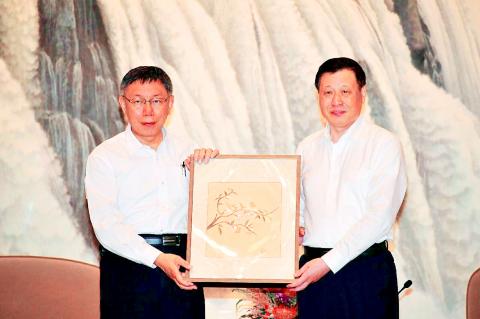The “two sides of the [Taiwan] Strait are one family,” Taipei Mayor Ko Wen-je (柯文哲) reiterated yesterday at the opening ceremony of the Taipei-Shanghai twin-city forum, the third time he has used the phrase in Shanghai, while Shanghai Mayor Ying Yong (應勇) said that “the compatriots of both sides of the Strait are family members that wish each other well and love each other.”
“We have always held on to the belief that both sides of the Strait are one family,” Ying added.
Ko used the phrase, which has been criticized by pro-independence and other pan-green supporters, for the first time in his speech to the 2015 twin-city forum, and again at the 2017 forum.

Photo courtesy of the Taipei City Government
In his speech yesterday, the Taipei mayor noted that it was the 10th year the forum has been held and 33 memorandums of understanding have been signed, on a wide variety of issues, during the forums.
The original goal of the forum was for people on both sides of the Strait to have more chances to communicate with one another, to enhance goodwill toward each other and move toward positive cross-strait relations, he said.
“There should be continuity in the exchanges between both, and policies should have stability. We should respect the agreements that were signed and the history of our interactions,” Ko said.
“We should continue to push peaceful development of the two sides of the Strait on the existing political foundation, and together pursue a better future for the people of the two sides,” he said.
He has always believed that “an attitude of mutual trust” and the concept of “two sides of the Strait are one family” can help promote exchanges and enhance goodwill on both sides, he said.
Repeating his “five mutual principles” as his approach to enhance the well-being of people on both sides, Ko also he wanted to push for exchanges so that “everyone can get along with each other peacefully and for the people to live a better life, because after all, a peaceful development for both sides is a common wish.”
Asked by Taiwanese reporters after the ceremony to explain his “one family” idea, Ko said that “it is an expression of attitude, meaning ‘we will be friendly to your people, but we want you to be friendly to Taiwanese’” in return.
The Chinese-language China Times yesterday reported that Ko told Shanghai government officials, who greeted him at the airport on Wednesday, that Chinese government officials wanting to visit Taipei face many obstacles, which is an unhealthy situation for which he does not yet have a solution.
Later in the day the National Immigration Agency released a statement saying that the 94.57 percent of applications to visit Taiwan submitted by Chinese officials and professionals in the first five months of the year had been approved, and the approval rate last year was 94.46 percent, so the government was not making it difficult for Chinese officials to visit.
Additional reporting by CNA

Taiwan is to commence mass production of the Tien Kung (天弓, “Sky Bow”) III, IV and V missiles by the second quarter of this year if the legislature approves the government’s NT$1.25 trillion (US$39.78 billion) special defense budget, an official said yesterday. Commenting on condition of anonymity, a defense official with knowledge of the matter said that the advanced systems are expected to provide crucial capabilities against ballistic and cruise missiles for the proposed “T-Dome,” an advanced, multi-layered air defense network. The Tien Kung III is an air defense missile with a maximum interception altitude of 35km. The Tien Kung IV and V

The disruption of 941 flights in and out of Taiwan due to China’s large-scale military exercises was no accident, but rather the result of a “quasi-blockade” used to simulate creating the air and sea routes needed for an amphibious landing, a military expert said. The disruptions occurred on Tuesday and lasted about 10 hours as China conducted live-fire drills in the Taiwan Strait. The Civil Aviation Administration (CAA) said the exercises affected 857 international flights and 84 domestic flights, affecting more than 100,000 travelers. Su Tzu-yun (蘇紫雲), a research fellow at the government-sponsored Institute for National Defense and Security Research, said the air

Taiwan lacks effective and cost-efficient armaments to intercept rockets, making the planned “T-Dome” interception system necessary, two experts said on Tuesday. The concerns were raised after China’s military fired two waves of rockets during live-fire drills around Taiwan on Tuesday, part of two-day exercises code-named “Justice Mission 2025.” The first wave involved 17 rockets launched at 9am from Pingtan in China’s Fujian Province, according to Lieutenant General Hsieh Jih-sheng (謝日升) of the Office of the Deputy Chief of the General Staff for Intelligence at the Ministry of National Defense. Those rockets landed 70 nautical miles (129.6km) northeast of Keelung without flying over Taiwan,

A strong continental cold air mass is to bring pollutants to Taiwan from tomorrow, the Ministry of Environment said today, as it issued an “orange” air quality alert for most of the country. All of Taiwan except for Hualien and Taitung counties is to be under an “orange” air quality alert tomorrow, indicating air quality that is unhealthy for sensitive groups. In China, areas from Shandong to Shanghai have been enveloped in haze since Saturday, the ministry said in a news release. Yesterday, hourly concentrations of PM2.5 in these areas ranged from 65 to 160 micrograms per cubic meter (mg/m³), and pollutants were